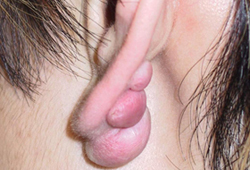Summary
Definition
History and exam
Key diagnostic factors
- history of inciting event (e.g., body piercing, surgery, vaccination)
- slow growth/lack of spontaneous regression
- erythematous, smooth, and shiny elevated scar with overhanging edge
Other diagnostic factors
- itch or pain
Risk factors
- history of prior keloid
- local skin tension
- follicular inflammation/infection
- family history of keloid and genetic factors
- dark skin types
- hormonal status
- systemic conditions (e.g., hypertension, atopic eczema, Castleman disease)
- lifestyle factors
Diagnostic tests
1st tests to order
- clinical diagnosis
Tests to consider
- skin biopsy
Treatment algorithm
small/single keloid
large/bulky/multiple keloids
Contributors
Authors
Ioannis Goutos, FRCSEd(Plast)
Consultant Plastic Surgeon
Director of Academic Plastic Surgery Programmes
Queen Mary University of London
London
UK
Disclosures
IG is an author of a number of references cited in this topic.
Richard Shaffer, MRCP, FRCR
Consultant Clinical Oncologist
GenesisCare
Cromwell Hospital
London
UK
Disclosures
RS wrote the radiotherapy section of this topic. At the time of writing, he had received funds as a consultant as clinical lead for GenesisCare for skin and benign radiotherapy and as medical director for XStrahl, which designs and manufactures radiotherapy machines that can be used to treat keloid scars. RS has spoken at educational events on radiotherapy for keloid scarring and other benign and malignant conditions and has a working relationship with plastic surgeons who refer patients for radiotherapy for keloid scarring.Since contributing to the topic, RS has declared that he treats patients with radiotherapy for keloid scars in the private sector for GenesisCare and has received consulting fees from GenesisCare. He is also reimbursed for being a medical director and a shareholder and board member of Xstrahl Limited. He is board member and president of International Organisation for Radiotherapy for Benign Conditions (a community interest company), and has given webinars on the topic of radiotherapy for keloid scars for them. He is director and chief medical officer of Theralife, a company formed to treat patients with radiotherapy for non-cancer conditions. He works clinically with Ioannis Goutos for the benefit of patients with keloid scars. RS will not make further contributions to this topic.
Acknowledgements
Mr Ioannis Goutos and Dr Richard Shaffer would like to gratefully acknowledge Professor Andrew Burd, and Dr Lin Huang, previous contributors to this topic.
Disclosures
AB and LH are authors of a number of references cited in this topic.
Peer reviewers
Edward E. Tredget, MD, MSc, FRCSC
Director
Firefighters' Burn Treatment Unit and Plastic Surgery Wound Healing Research Laboratory
Professor
Department of Surgery
University of Alberta
Edmonton
Alberta
Canada
Disclosures
EET declares that he has no competing interests.
Boni E. Elewski, MD
Professor and Chair of Dermatology
University of Alabama
Birmingham
AL
Disclosures
BEE declares that she has no competing interests for this topic.
Peer reviewer acknowledgements
BMJ Best Practice topics are updated on a rolling basis in line with developments in evidence and guidance. The peer reviewers listed here have reviewed the content at least once during the history of the topic.
Disclosures
Peer reviewer affiliations and disclosures pertain to the time of the review.
References
Key articles
Ogawa R. The most current algorithms for the treatment and prevention of hypertrophic scars and keloids: a 2020 update of the algorithms published 10 years ago. Plast Reconstr Surg. 2022 Jan 1;149(1):79e-94e.Full text Abstract
Ogawa R, Akita S, Akaishi S, et al. Diagnosis and treatment of keloids and hypertrophic scars - Japan Scar Workshop consensus document 2018. Burns Trauma. 2019;7:39. Abstract
Gold MH, Berman B, Clementoni MT, et al. Updated international clinical recommendations on scar management: part 1 - evaluating the evidence. Dermatol Surg. 2014 Aug;40(8):817-24. Abstract
Royal College of Radiologists. Recommendations for using radiotherapy for benign disease in the UK. 2023 [internet publication].Full text
Reference articles
A full list of sources referenced in this topic is available to users with access to all of BMJ Best Practice.

Differentials
- Hypertrophic scar
- Dermatofibrosarcoma protuberans
- Dermatofibroma
More DifferentialsGuidelines
- Recommendations for using radiotherapy for benign disease in the UK: keloid scarring
- S2k guidelines for the therapy of pathological scars (hypertrophic scars and keloids)
More GuidelinesLog in or subscribe to access all of BMJ Best Practice
Use of this content is subject to our disclaimer